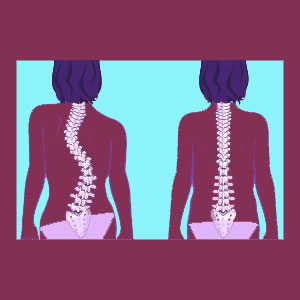
S curve scoliosis, also called multiple scoliosis, describes a curvature in the shape of the letter S that progresses in opposite directions, with more than one apex present. S curvatures virtually always contain 2 distinct curvatures, although technically it is possible that they contain 3 in cases of wide-ranging cervicothoracolumbar profiles.
S curvatures are only different to C shaped curvatures in design. They are no more likely to become symptomatic or disabling, nor are they any more innocent, easier to treat or easier to diagnose. Some doctors consider S curvatures to be more self-balancing, but this logic only applies to particular cases where the curvature follows symmetrical patterns of progression, generally keeping much of the spine in and around the center line of sagittal neutrality.
This discussion centers on the occurrence of S shaped scoliotic curvatures in the human vertebral column. We will compare multiple curvatures to single curvature conditions and discuss why the shape of the atypical curvature rarely predicts much about its progression or symptomology.
S Curve Scoliosis and C Shaped Scoliosis
Symmetrical S curvatures tend to discourage torso tilting when compared to C shaped curvatures. However, this is not always a rule. S curvatures tend to cause one shoulder to project forward, while the opposite hip tends to project rearwards. Sometimes, this pattern is reversed, with the hip forward and opposite shoulder rearwards.
S curvatures tend to be longer and involve more vertebrae than most C shaped curvatures. They also tend to be found in scoliosis that affects more than one region of the spine, such as cervicothoracolumbar, cervicothoracic and thoracolumbar, although some cases exist completely contained within the thoracic area, as well.
S Curve Scoliosis Patterns
Some S curves are very symmetrical, with virtually equal curvatures being demonstrated above and below. These types of symmetrical curves tend to limit progression to some extent and also minimize the effects on posture and the overall visual presentation of the condition in mild to moderate cases.
Other S curvatures are not symmetrical and contain a much larger curve and a smaller curvature top or bottom. These S curvatures tend to present more closely to C curvatures in their primary section, with only minimal influence of the remaining aspect of the S curve on posture and overall form.
S curvatures where the first curvature does not come all the way back around to the point of spinal neutrality tend to be much worse symptomatically and visually. This is because the second curvature does not balance the original curve, but instead continues it is a singular direction (left or right) away from the mid line of the vertebral column, exacerbating torso tilting, as well as the increasing the overall effects on posture and anatomical symmetry.
S Curve Scoliosis Facts
Doctors have long tried to discover why some scoliotic formations tend to be singularly curved, while others tend to become multiply curved. In cases of idiopathic scoliosis, which accounts for the vast majority of patient profiles, no conclusive evidence exists that provides any real clue on the answer to this query. However, for many instances of developed scoliosis, there are verifiable spinal or muscular causations than explain why a curvature might assume a given shape or configuration.
The important thing to remember is that neither S nor C shaped curvatures are inherently worse and neither will dispose a patient towards a particular progression. There are certainly more important classification characteristics of a spinal curvature that will provide more telling prognosis for its progression, including the degree of curvature, the number of vertebra affected and the overall psychoemotional state of the patient in relation to their scoliosis.
Scoliosis > Side to Side Spinal Curvature > S Curve Scoliosis





